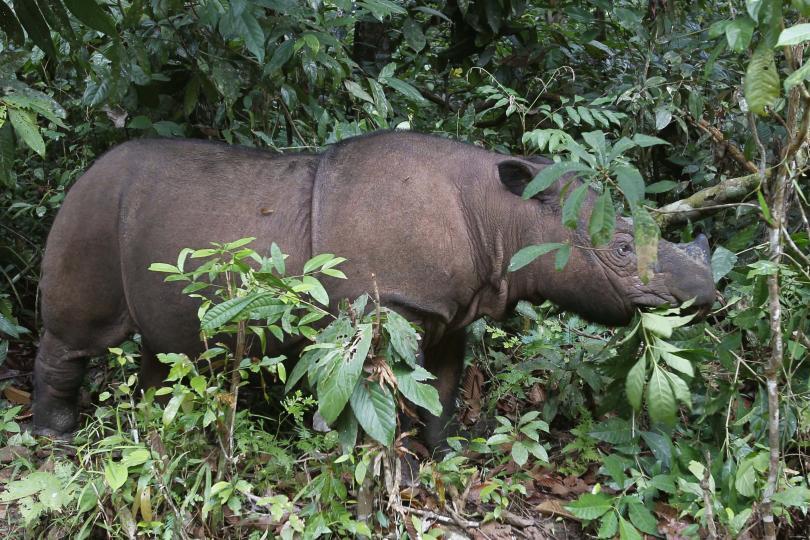A rare Sumatran rhinoceros, whose discovery less than a month ago was considered an enormous conservation success, has died. The female rhino was captured on the Indonesian part of Borneo island where the animal was believed to be long extinct.
Nyoman Iswarayoga, a spokesman for World Wildlife Fund Indonesia, said Wednesday that the rhino, named Najaq, died of a leg infection from wounds believed to have been inflicted by poaching traps, the Associated Press reported. Indonesia’s environment ministry confirmed to Agence France-Presse (AFP) that the rhino succumbed to the infection after her health deteriorated.
“The death of this Sumatran rhino proves they exist on Borneo, so we will continue protecting them,” Tachrir Fathoni, a senior official at the environment ministry, told AFP. The ministry added that an autopsy is being conducted to determine its official cause of death.
According to reports, an estimated 100 Sumatran rhinos remain, mostly in Sumatra, and nine are in captivity. The rhino species, which is the only haired rhinos in the world, is threatened and concerns over its extinction continue because of its poaching for horns and habitat loss.
The rare Sumatran rhino’s discovery was praised by the WWF as “a major milestone for rhino conservation in Indonesia.”
“This is an exciting discovery and a major conservation success,” Efransjah, the chief executive of WWF-Indonesia, who has been identified only by one name, reportedly said at the time. “We now have proof that a species once thought extinct in Kalimantan still roams the forests, and we will now strengthen our efforts to protect this extraordinary species.”
The Sumatran rhinoceros
The Sumatran rhinoceros, also known as hairy rhinoceros or Asian two-horned rhinoceros, is a rare member of the family Rhinocerotidae and one of five extant rhinoceroses. It is the only extant species of the genus Dicerorhinus. It is the smallest rhinoceros, although it is still a large mammal.
Like both African species, it has two horns; the larger is the nasal horn, typically 15–25 cm (5.9–9.8 in), while the other horn is typically a stub. A coat of reddish-brown hair covers most of the Sumatran rhino’s body.
Members of the species once inhabited rainforests, swamps, and cloud forests in India, Bhutan, Bangladesh, Myanmar, Laos, Thailand, Malaysia, Indonesia, and China. In historical times, they lived in southwest China, particularly inSichuan. They are now critically endangered, with only six substantial populations in the wild: four on Sumatra, one on Borneo, and one in the Malay Peninsula. Their numbers are difficult to determine because they are solitary animals that are widely scattered across their range, but they are estimated to number fewer than 100. Survival of the Peninsular Malaysia population is in doubt, and one of the Sumatran populations may already be extinct. Total numbers today may be as low as 80. In 2015, researchers announced that the Eastern Sumatran rhinoceros is extinct from north part of Borneo (Sabah, Malaysia).
The Sumatran rhino is a mostly solitary animal except for courtship and offspring-rearing. It is the most vocal rhino species and also communicates through marking soil with its feet, twisting saplings into patterns, and leaving excrement. The species is much better studied than the similarly reclusive Javan rhinoceros, in part because of a program that brought 40 Sumatran rhinos into captivity with the goal of preserving the species. The program was considered a disaster even by its initiator; most of the rhinos died and no offspring were produced for nearly 20 years, representing an even worse population decline than in the wild. In March 2016, a Sumatran rhinoceros has been spotted in the Indonesian Borneo.











